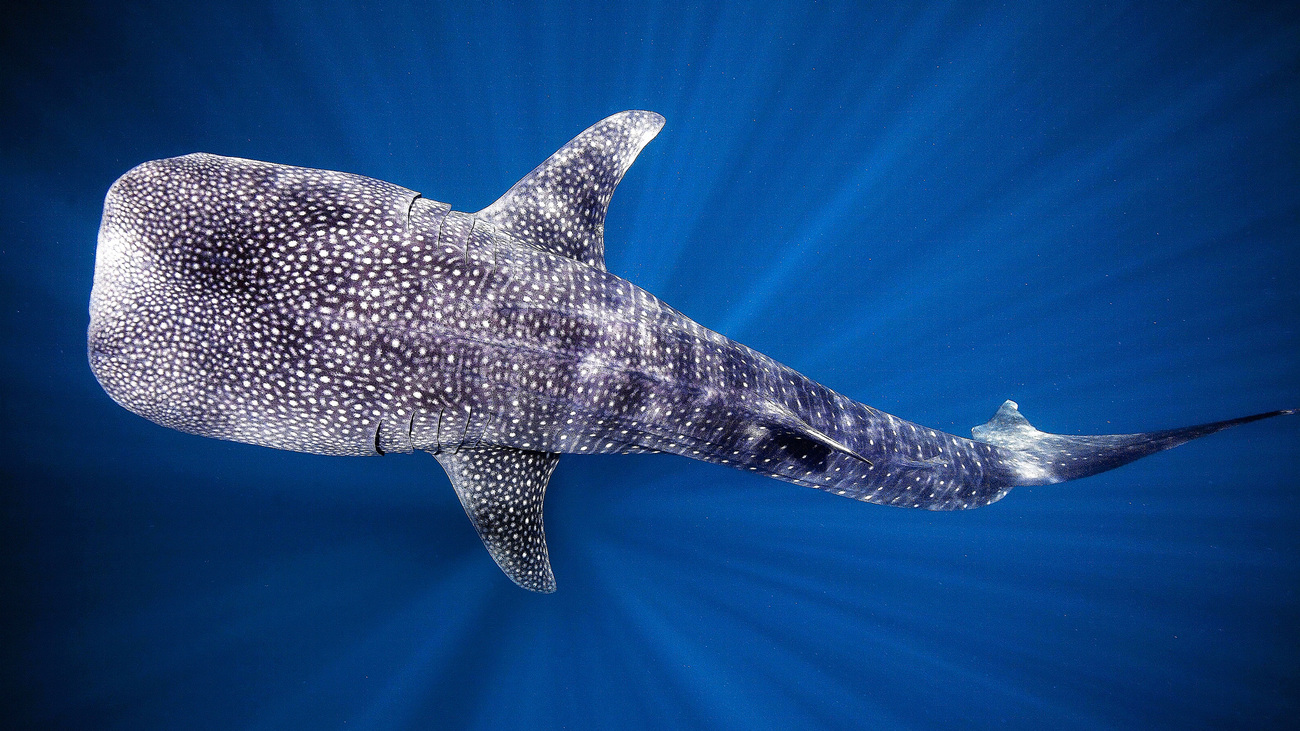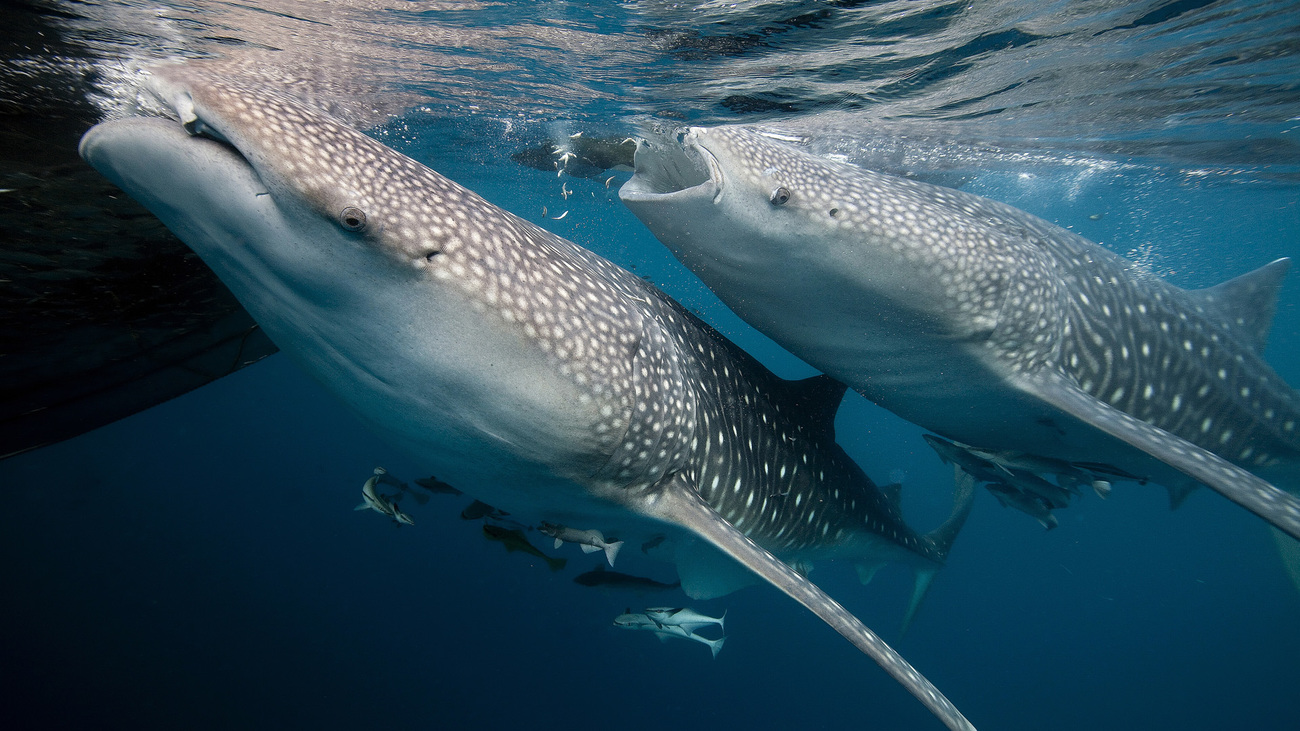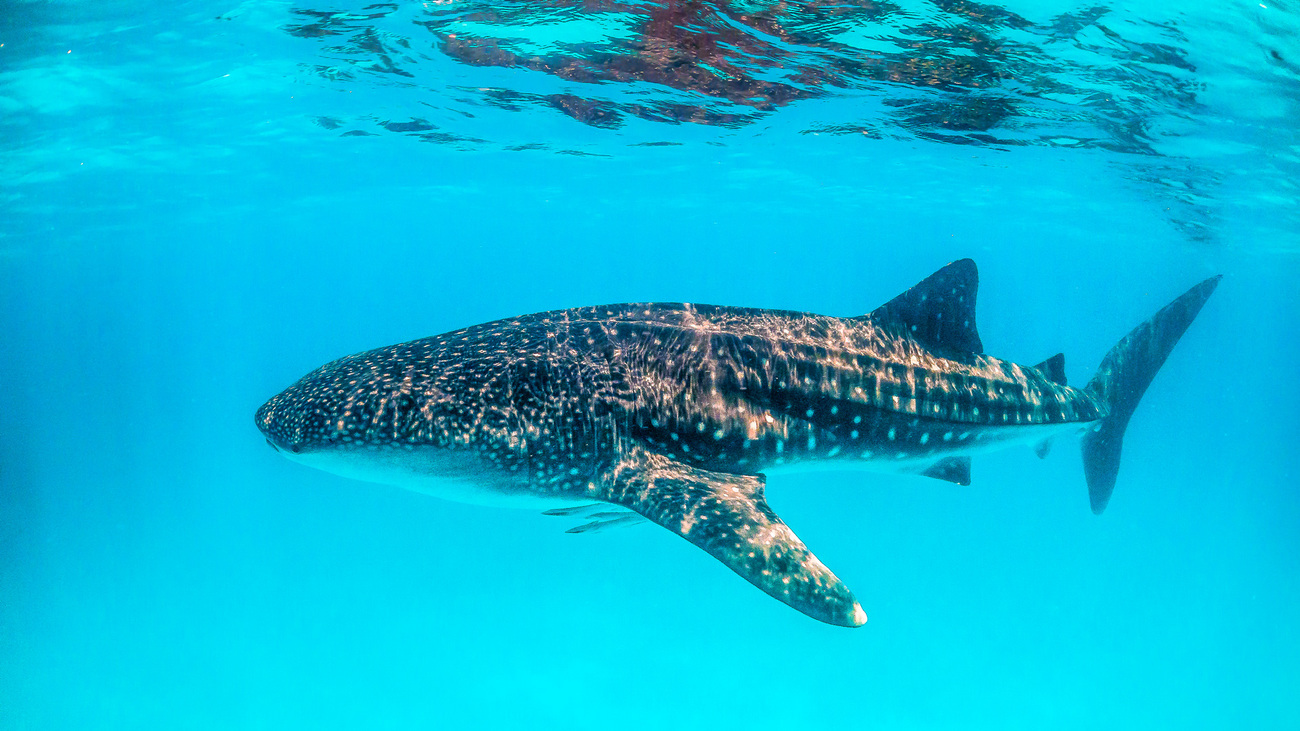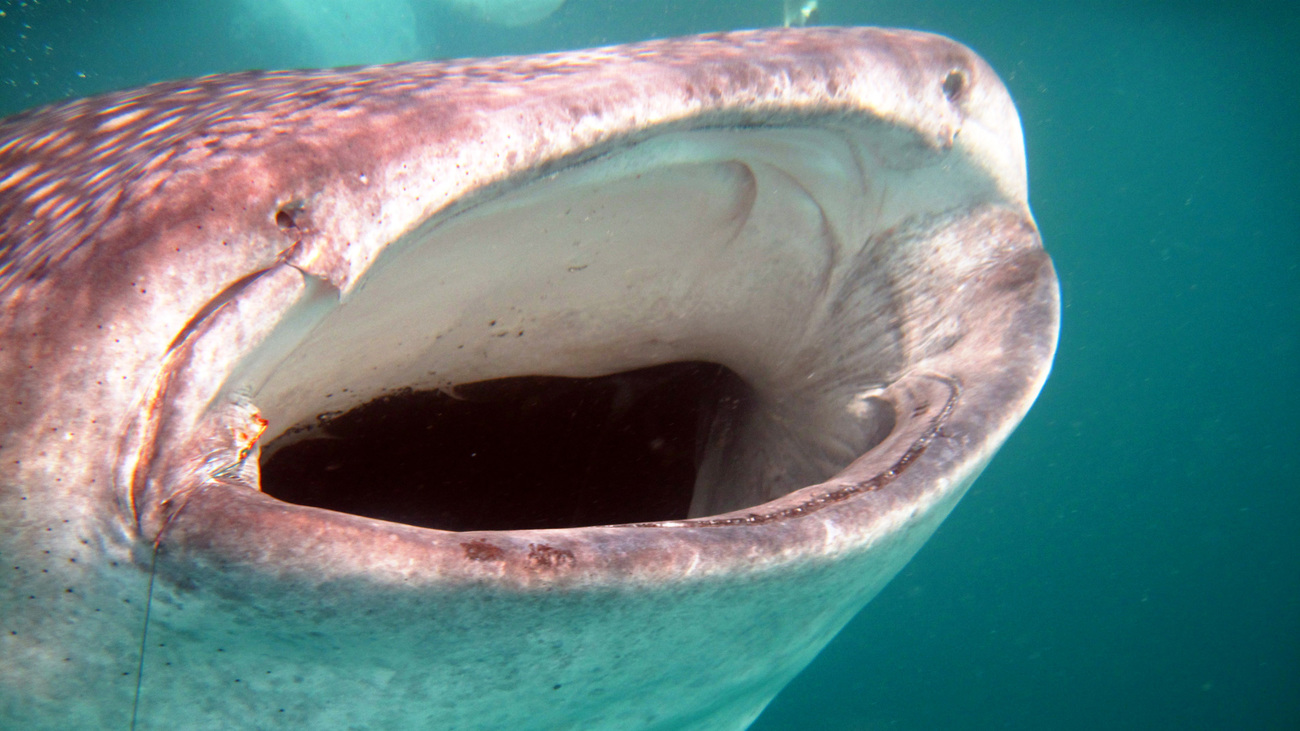Whale sharks
Whale sharks are the biggest fish in the world and possibly the biggest to have ever existed. They can be found in warm tropical waters around the globe and cruise along the ocean surface to find food. The biggest whale shark on record was 19 metres long and weighed more than 15 tonnes. Despite their terrifying size, they are called the sea’s gentle giants. As filter-feeders, whale sharks don’t hunt or stalk, and their interactions with humans are peaceful and curious.
The markings on a whale shark’s body make them instantly recognisable. They have dark skin with light horizontal and vertical lines that create a chequered pattern across their bodies. They also have hundreds of lightly coloured spots covering the darker areas of their skin, while their bellies are white. As filter feeders, whale sharks eat by opening their huge mouths, swallowing water, and passively filtering small creatures with their mesh-like gills, which they then swallow.
Not a lot is known about the lives of whale sharks because they’re difficult to track and study, both when alive and when deceased. This is because, as fish, whale sharks have no bones. Instead, their skeletons are made of bendy cartilage (like human noses) which doesn’t fossilise well. As a result, not much is known about their mating rituals, life span, or social tendencies.
Importantly, whale sharks help their environment by controlling the levels of plankton and algae. Excessive amounts of either of these would decrease the amount of sunlight and oxygen in the water, disrupting the natural ecosystem. A range of smaller fish also feed off the external parasites that live on whale sharks’ skin and swim in close proximity to them to protect themselves from other predators.
What is a whale shark’s scientific name?
The whale shark’s scientific name is Rhincodon typus. It is the only member of the genus Rhincodon, which scientists class as its own family, though it is sometimes also classed under the Orectolobidae family (carpet sharks).
Are whale sharks endangered?
Whale sharks are listed as endangered on the IUCN Red List, and their populations are currently decreasing. They face a range of threats, including vessel strikes, bycatch, fisheries, finning, tourism, and climate change.
According to the IUCN, whale sharks have a recovery score of 29%. This means they are almost a third of the way towards full recovery—a target that is reached when a species is present, thrives, and performs its ecological functions in all parts of its range.
Where do whale sharks live?
Whale sharks have a circumtropical distribution, which means their range extends around the globe and is made up of tropical waters. Their range covers too many countries to list, and they are present in the Indian, Atlantic, and Pacific Oceans.
The southernmost part of their range includes the waters around the southernmost points of Africa and Australia. The northernmost part of their range includes the waters off the coast of Boston and New York. Outside of this range, the waters become too cold for whale sharks.
Threats
Whale sharks face a number of manmade threats, including finning, bycatch, tourism, and climate change.

Vessel strikes
There is considerable overlap between whale shark hotspots and industrial shipping routes, which has led to an increase in vessel strikes. Though the exact number of sharks affected is unknown, marine biologists fear that vessel strikes may be far more common than previously estimated. Despite their large size and thick skin, collisions with large vessels are often fatal for whale sharks.
Bycatch
Bycatch refers to fish that are accidentally caught in fishing nets and other large-scale fishing practices, even though they are not the intended target. It’s possible for almost any species to be accidentally caught—and whale sharks are no exception.
Those that are caught are usually killed and discarded. If a whale shark does escape, they are often left injured and maimed.
Fisheries and finning
Finning is an inhumane practice that involves catching sharks, sawing off their fins while they are still alive, and then throwing their bodies back into the water, where they die slow and painful deaths.
These fins are used in traditional dishes, including shark fin soup, in Asia, where the demand for shark fins has been steadily rising in recent years. Despite regulations and bans across many areas, estimates suggest as many as 73 million sharks are finned each year.
Tourism
While whale sharks don’t seem to mind human divers swimming beside them, it may disrupt their feeding patterns and other parts of their lives. The growing popularity of such activities also increases the number of boats travelling to shark-inhabited waters, which could result in more vessel strikes.
Climate change
Rapidly warming waters affect marine life and ecosystems in many ways. One dangerous side effect is the mass migration of creatures moving from familiar waters that are becoming too hot to cooler waters in new regions. This has resulted in more shark sightings along coasts, which can result in more human-shark interactions.
FAQs
What does a whale shark look like?
The whale shark is both the largest shark and the largest fish in the world. It has a broad, flat-shaped head and extremely large mouth used to catch its prey, with two eyes on either side. Its distinctive markings include lightly coloured horizontal and vertical lines over its dark skin and light spots across the darkest areas of the body.

What do whale sharks eat?
Whale sharks are filter-feeders, which means they catch prey by allowing water to flow into their mouths and out of their gills, while small creatures are caught in the gills and swallowed.
A shark catches a range of prey using this feeding method, the most common of which are zooplankton (such as shrimp) and phytoplankton (such as algae). However, larger creatures like sardines, anchovies, mackerel, squid, tuna, and albacore are also commonly caught and eaten.
Do whale sharks eat people?
No. Whale sharks are filter feeders, meaning they feed on the tiny species of plankton and krill that swim into their large, open mouths. They don’t eat large animals or use any hunting or chasing behaviours to obtain their food.
Are whale sharks dangerous?
Whale sharks have been approached by divers on numerous occasions and haven’t displayed any violent behaviour. However, you should always be careful when close to a wild animal, ensuring you don’t make them feel stressed or threatened.
Is a whale shark a shark or a whale?
The whale shark is the largest species of shark (and fish) in the world—hence the name ‘whale’—but they are not whales, as they are fish, not mammals. They’re also often referred to as ‘gentle giants’ due to their size.
Do whale sharks have teeth?
Whale sharks do have teeth—over 3,000 arranged in more than 300 rows. However, they don’t just have teeth in their mouths—they also have tiny teeth clustered around their irises. Scientists have observed more than 3,000 tiny teeth on each eye. They’re most likely used as protection, since a whale shark doesn’t have eyelids and its eyes stick out of the side of its head.
How long do whale sharks live?
As it’s difficult to study whale sharks, scientists aren’t sure how long whale sharks live. However, current estimates suggest their lifespan is about 60 to 100 years.
How big is a whale shark?
While the biggest whale shark measured was almost 19 metres (62 feet) long, most reach lengths of around 12 metres (32 feet).
How much does a whale shark weigh?
The average weight of a whale shark (according to a fairly small sample of specimens) is around 14 metric tonnes (about 31,000 pounds).
Is a whale shark bigger than a blue whale?
Blue whales are much bigger than whale sharks—the biggest blue whale ever recorded was 33 metres long, while the largest measured whale shark was 19 metres long. However, whale sharks are still the biggest fish on Earth and the biggest known fish to have ever existed.
Do whale sharks have predators?
Whale sharks don’t have any natural predators in their ecosystems because they are at the top of the food chain. Their young can sometimes be attacked by other sharks and marine predators, but once they grow to full size, they don’t face this threat. However, humans pose a threat as an unnatural predator. Illegal hunting and poaching affect sharks, and they also fall victim to collisions with large boats.
Do whale sharks lay eggs?
Not a lot is known about the reproductive habits of whale sharks, but scientists believe they give birth to fully-formed young and don’t lay eggs. The average litter contains around 16 young but much larger litters are also possible—a pregnant female was once caught in Taiwan that had nearly 300 young in her uterus.
Why are whale sharks important?
Sharks benefit their environments in many ways, but one of their most important roles is that of the apex predator. They are the top predators in the ocean, and this means they control the populations of smaller predators, making sure prey species aren’t overly predated. When shark populations significantly decline, smaller predator populations increase, and they consume more than their ecosystems can sustain.
Why are whale sharks endangered?
Though they don’t have natural predators, whale sharks face a number of threats caused by humans. These include fishing-related threats like bycatch and finning, transportation-related threats like vessel strikes and tourism, and climate change.
Our work
Whale sharks are the biggest fish and sharks in the world, but they are endangered and under threat from unregulated fishing for their meat, fins, and oil, in addition to facing entanglements and vessel strikes.
In 2004, IFAW’s partner organisation in India, Wildlife Trust of India (WTI), launched its Save the Whale Shark campaign, aimed at spreading awareness of the plight of these majestic animals and their protected status among coastal communities in Gujarat on India’s west coast. The campaign helped convert fishers into conservationists and brought about change in the perception and attitudes of local people. Since then, fishers have rescued and released 851 whale sharks off Gujarat through a scheme to compensate fishers for damage to nets as a result of their efforts to release whale sharks alive.
IFAW’s current work in coastal Kenya also focuses on threat reduction and the conservation of whale sharks, which are known to frequent Kenya’s coastal waters.

How can you help?
IFAW is working to combat threats to marine life like vessel strikes, bycatch, and climate change. Learn more about our current projects and how we help protect whale sharks and other amazing animals.
